A projector provides an unforgettable home theater experience that even the best televisions are not capable of. However, there is only one setback—projector screens are costly and may break the bank.
Our team will provide cost-effective tips on finding projector screen paint, including the basic things about finding the best paints, factors to consider, and how to apply them to your wall.
Projector Screen Paint
Projector Brightness
When choosing the best paint products on your home theater screen, one of the things you should consider is the projector’s brightness. Home theater projectors have different shapes and screen size, and they also come in a wide range of brightness measured in lumens.
It is also important to note when choosing a home theater projector screen paint, a white screen will reflect more light and will appear brighter compared to dark-colored screens. But if your projector can produce at least 3000 lumens, you could paint your walls with dark colors such as black or gray for an optimal viewing experience.
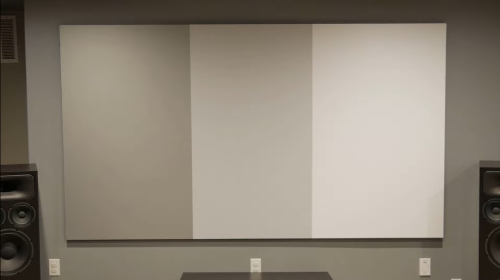
Light in the Room
Believe it or not, the room’s lighting will have a considerable influence when choosing a screen paint or screen material for your walls. Determining how much light to use and where to place it is a common issue. The most important thing to remember is to keep light away from the screen.
Our experts suggest that the amount of light should be kept as far away from the screen as possible. Recessed spotlighting is useful for illuminating specific areas of a room. However, if you have ambient light entering through the doors or windows, it is highly recommended to have white-colored screen paint. But to truly experience the best cinematic image and experience, a dark and light-controlled living room with black or gray color is the way to go.
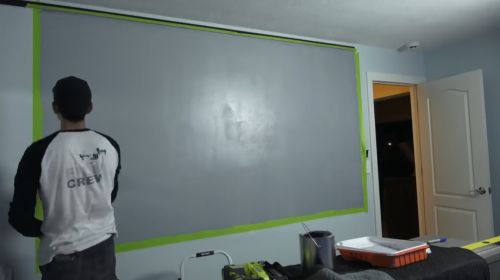
Purpose of Projector
What is the purpose of your projector? What will you be watching? Is it intended to be a theater room? These are some questions that you might want to ask before picking the best choice for your screen.
Will your projector be used for entertainment purposes such as watching a movie or playing games? Or will your option be using it for educational purposes or business presentations?
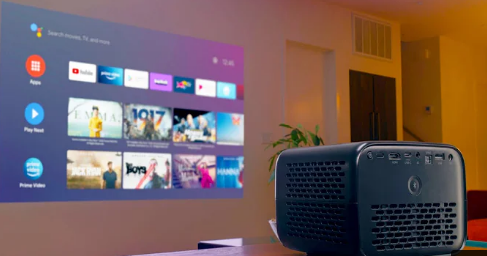
The projector screen comes in three primary colors: white, grey, and silver. However, the silver screen is the oldest type and the best option.
If you plan to use your high-quality home theater projector for video games and watch HD movies, you would need color with a slightly higher reflectivity to create the necessary contrast. But if you plan to watch 3D movies, our experts advise that the perfect solution is to have all your walls painted white.
Color Balance
Another essential factor to consider for your projector screen is its color balance and color saturation. All starts with the color balance as this will serve as your foundation – having a lousy base color is like building a house on a bad foundation.
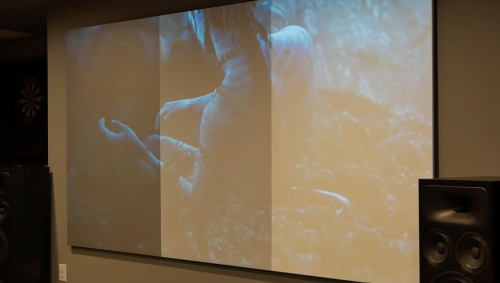
When it comes to color and tint, your best option is to prioritize skin tones. Find a sequence that includes a close-up image of people. Simply move the color slider until they appear normal. Colors that are warm and rosy have an immediate project for picture quality.
The proper color balance [1] can have noticeable benefits, such as reducing hot-spotting, increasing gain, and even adding some image depth.
(For quality projectors, you can also check our list of excellent short-throw projectors here)
Paint Finish
The last thing you might want to consider for your search is the type of paint finish where you can usually buy in a hardware store. You could choose one type of paint on screen finishes such as textured, matte, eggshell, satin, semi-gloss, and high gloss. To create an ideal projector central, our team of experts suggests that the most suitable is the satin finish as it performs well for projector screens in terms of quality and clarity.
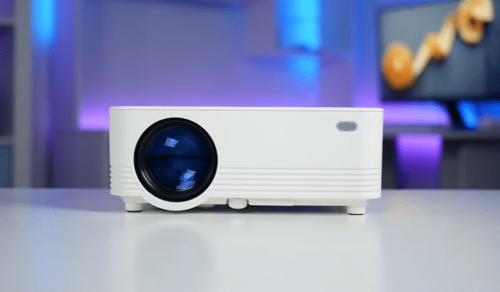
How to Paint Your Wall
Prepare Wall
After sleepless nights of picking and choosing the right paint and product line for your projector screen wall, the fun part has now come: painting your projector wall.
The first step when painting your wall is to prepare it. Inspect for all wall surface flaws such as cracks, holes, or stains. Then make sure that it is flat as possible and there is no unevenness. It is also essential to clean the wall and remove any dirt or dust as it can negatively affect you when you start painting the wall and establishing your projector central. You may also apply a wall putty on your walls to ensure a smooth and even surface – it could also prolong the paint’s life.
Add Paint Base
The next step is to apply a paint base or primer on the screen area where the image is reflected. Using a primer provides several benefits, such as helping the primary wall color stick and stand out. Applying primer to the coverage area and new surface seals the original material, preventing paint from absorbing it. It also reduces the number of coats you need to apply to your wall. For most wall painting jobs, a primary and standard white color primer will be your best choice.
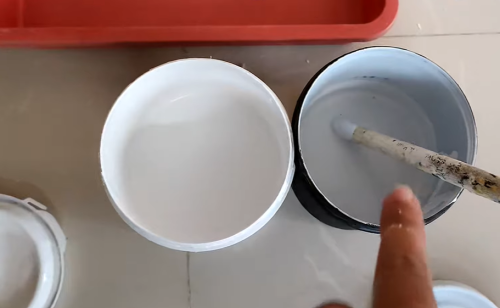
Paint Your Wall
After completing the first two steps, you are now ready for your wall. When painting, you may choose to use a roller or spray gun as your medium for painting – but we prefer that you use a spray gun to prevent lumps on your wall.
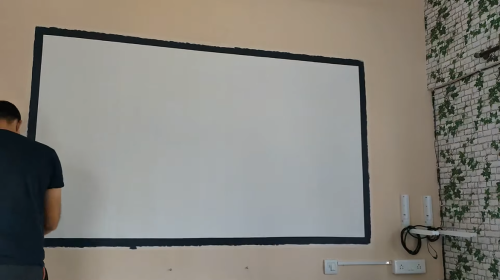
Also, don’t forget to mix your paint thoroughly for an even consistency. And for best results, you should apply two to three additional coats. Although our experts recommend that you get some professional help when painting over your wall, doing it yourself is highly achievable as well.
For the best home theater setup, you can connect your projectors to speakers using this guide.
FAQ
What is the best color to paint a wall for a projector?
The best color to paint a wall for a projector screen is a color closer to gray than white as it creates a sharper image and better video quality. Normally, you should choose a darker color like gray paint options if your projector’s specs say it produces more than 3,500 lumens.
Does projector paint make a difference?
Yes, having projector paint makes a difference. Most of us use a painted wall as a projector screen as it is a relatively cheaper method to watch high-quality media on a large screen. And with projector paint, you won’t have to worry about aspect ratio as you can paint your wall in any dimension you desire. Although using projector paint will slightly decrease the viewable image’s quality, it is still a great alternative to use.
Conclusion
Finding the right projector screen color for your walls is undoubtedly difficult with several factors you may need to consider. But if you want to get the best watching experience from your projectors, you should follow the guide we have provided for you. It involves finding the right balance, choosing the best paint finish, and proper ways to paint your walls. Hopefully, our team has been successful at providing you relevant information regarding projector screen paints.
For related pages, you can check out the following:
